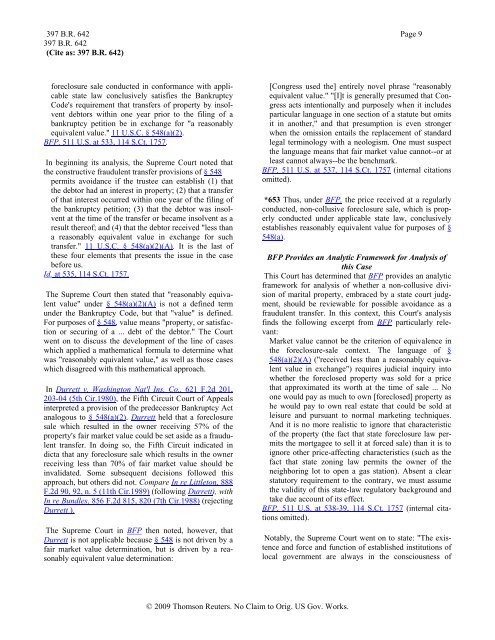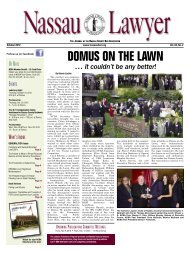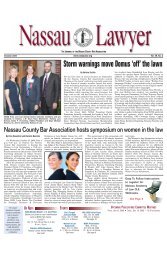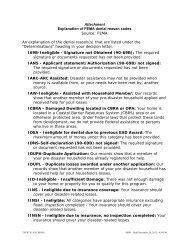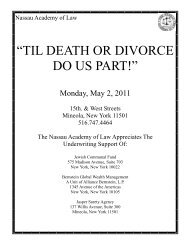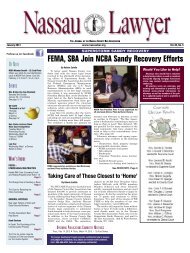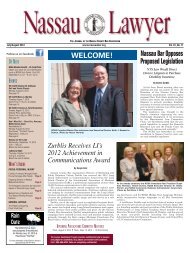397 B.R. 642 Page 9397 B.R. 642(Cite as: 397 B.R. 642)foreclosure sale conducted in conformance with applicablestate law conclusively satisfies the BankruptcyCode's requirement that transfers <strong>of</strong> property by insolventdebtors within one year prior to the filing <strong>of</strong> abankruptcy petition be in exchange for "a reasonablyequivalent value." 11 U.S.C. § 548(a)(2).BFP, 511 U.S. at 533, 114 S.Ct. 1757.In beginning its analysis, the Supreme Court noted thatthe constructive fraudulent transfer provisions <strong>of</strong> § 548permits avoidance if the trustee can establish (1) thatthe debtor had an interest in property; (2) that a transfer<strong>of</strong> that interest occurred within one year <strong>of</strong> the filing <strong>of</strong>the bankruptcy petition; (3) that the debtor was insolventat the time <strong>of</strong> the transfer or became insolvent as aresult there<strong>of</strong>; and (4) that the debtor received "less thana reasonably equivalent value in exchange for suchtransfer." 11 U.S.C. § 548(a)(2)(A). It is the last <strong>of</strong>these four elements that presents the issue in the casebefore us.Id. at 535, 114 S.Ct. 1757.The Supreme Court then stated that "reasonably equivalentvalue" under § 548(a)(2)(A) is not a defined termunder the Bankruptcy Code, but that "value" is defined.For purposes <strong>of</strong> § 548, value means "property, or satisfactionor securing <strong>of</strong> a ... debt <strong>of</strong> the debtor." The Courtwent on to discuss the development <strong>of</strong> the line <strong>of</strong> caseswhich applied a mathematical formula to determine whatwas "reasonably equivalent value," as well as those caseswhich disagreed with this mathematical approach.In Durrett v. Washington Nat'l Ins. Co., 621 F.2d 201,203-04 (5th Cir.1980), the Fifth Circuit Court <strong>of</strong> Appealsinterpreted a provision <strong>of</strong> the predecessor Bankruptcy Actanalogous to § 548(a)(2). Durrett held that a foreclosuresale which resulted in the owner receiving 57% <strong>of</strong> theproperty's fair market value could be set aside as a fraudulenttransfer. In doing so, the Fifth Circuit indicated indicta that any foreclosure sale which results in the ownerreceiving less than 70% <strong>of</strong> fair market value should beinvalidated. Some subsequent decisions followed thisapproach, but others did not. Compare In re Littleton, 888F.2d 90, 92, n. 5 (11th Cir.1989) (following Durrett), withIn re Bundles, 856 F.2d 815, 820 (7th Cir.1988) (rejectingDurrett ).The Supreme Court in BFP then noted, however, thatDurrett is not applicable because § 548 is not driven by afair market value determination, but is driven by a reasonablyequivalent value determination:[Congress used the] entirely novel phrase "reasonablyequivalent value." "[I]t is generally presumed that Congressacts intentionally and purposely when it includesparticular language in one section <strong>of</strong> a statute but omitsit in another," and that presumption is even strongerwhen the omission entails the replacement <strong>of</strong> standardlegal terminology with a neologism. One must suspectthe language means that fair market value cannot--or atleast cannot always--be the benchmark.BFP, 511 U.S. at 537, 114 S.Ct. 1757 (internal citationsomitted).*653 Thus, under BFP, the price received at a regularlyconducted, non-collusive foreclosure sale, which is properlyconducted under applicable state law, conclusivelyestablishes reasonably equivalent value for purposes <strong>of</strong> §548(a).BFP Provides an Analytic Framework for Analysis <strong>of</strong>this CaseThis Court has determined that BFP provides an analyticframework for analysis <strong>of</strong> whether a non-collusive division<strong>of</strong> marital property, embraced by a state court judgment,should be reviewable for possible avoidance as afraudulent transfer. In this context, this Court's analysisfinds the following excerpt from BFP particularly relevant:Market value cannot be the criterion <strong>of</strong> equivalence inthe foreclosure-sale context. The language <strong>of</strong> §548(a)(2)(A) ("received less than a reasonably equivalentvalue in exchange") requires judicial inquiry intowhether the foreclosed property was sold for a pricethat approximated its worth at the time <strong>of</strong> sale ... Noone would pay as much to own [foreclosed] property ashe would pay to own real estate that could be sold atleisure and pursuant to normal marketing techniques.And it is no more realistic to ignore that characteristic<strong>of</strong> the property (the fact that state foreclosure law permitsthe mortgagee to sell it at forced sale) than it is toignore other price-affecting characteristics (such as thefact that state zoning law permits the owner <strong>of</strong> theneighboring lot to open a gas station). Absent a clearstatutory requirement to the contrary, we must assumethe validity <strong>of</strong> this state-law regulatory background andtake due account <strong>of</strong> its effect.BFP, 511 U.S. at 538-39, 114 S.Ct. 1757 (internal citationsomitted).Notably, the Supreme Court went on to state: "The existenceand force and function <strong>of</strong> established institutions <strong>of</strong>local government are always in the consciousness <strong>of</strong>© 2009 Thomson Reuters. No Claim to Orig. US Gov. Works.
397 B.R. 642 Page 10397 B.R. 642(Cite as: 397 B.R. 642)lawmakers and, while their weight may vary, they maynever be completely overlooked in the task <strong>of</strong> interpretation."511 U.S. at 539-40, 114 S.Ct. 1757, citing DaviesWarehouse Co. v. Bowles, 321 U.S. 144, 64 S.Ct. 474, 88L.Ed. 635 (1944).Also noteworthy is that the Supreme Court in BFP didnot differentiate between foreclosure sales conducted undercourt supervision (judicial foreclosures) and foreclosuresales conducted without court supervision (nonjudicialforeclosures). Rather, the Supreme Court only refersto a "properly noticed foreclosure sale." BFP, 511 U.S. at533, 114 S.Ct. 1757. Under California law, the applicablelaw at issue in BFP, a foreclosure sale may be conductedeither judicially (See Cal.Civ.Code § 2931 (West 2008))or non-judicially (See Cal.Civ.Proc.Code § 725a (West2008)).In New York, as presumably in every state <strong>of</strong> the UnitedStates, divorces and the division <strong>of</strong> assets incident thereto,occur solely under the auspices <strong>of</strong> an institution <strong>of</strong> localgovernment--namely, a state court. Further, as in a foreclosuresale, parties to a divorce proceeding are not requiredto market their marital residence for sale the way ahome being sold by a willing seller would be sold. Divorcingparties do not always sell their marital residenceon the open market through a multiple listing service orvia some other recognized real estate sales device. In addition,various assets owned by a divorcing couple thatare subject to being divided as marital property, such asrights in pension plans, IRAs, stock in closely held companies,life insurance policies, and similar assets, have norecognized mechanism for public sale, or even a readymarket for public sale. Other assets constituting maritalproperty, such as refrigerators, couches, golf clubs, andtelevisions, could *654 today be sold through publicmeans not readily in use in 1984, such as on internetbasedauction sites, but such sales would not necessarilygenerate fair market value. Divorcing parties are not necessarilywilling sellers.Further, divorcing parties divide assets for many reasonsother than achieving economic equivalency. Among theseare the need to adjust assets based upon ongoing custodyand support <strong>of</strong> children, sentimental attachment to familyheirlooms, ending the incurrence <strong>of</strong> the economic costs <strong>of</strong>the divorce proceeding itself, and, <strong>of</strong>ten, the necessity <strong>of</strong>bringing closure to what can be a difficult, expensive,emotional and energy consuming process.Absent Extrinsic Fraud or Collusion, a Divorce DecreeThat Incorporates aSettlement Conclusively Establishes Reasonably EquivalentValueHere, this Court has determined that, absent extrinsicfraud or collusion among the divorcing parties, the division<strong>of</strong> marital assets which is agreed to by the parties,and is contemporaneously or subsequently approved by amatrimonial court, and incorporated into a divorce decree,conclusively establishes reasonably equivalent value.[10] This Court follows in part the decision in Bledsoe,which holds that a bankruptcy court should not interferewith the outcome <strong>of</strong> a state court divorce action, whichwas the result <strong>of</strong> a regularly conducted proceeding understate law, absent pro<strong>of</strong> <strong>of</strong> collusion or other extrinsicfraud. 350 B.R. at 520. However, Bledsoe differs significantlyfrom this case in one significant respect. InBledsoe, the parties did not enter into a divorce settlement--thedivision <strong>of</strong> marital assets was determined by thematrimonial court without the agreement <strong>of</strong> the parties.In Bledsoe, the debtor's petition for relief was filed onMay 10, 2004. Prior thereto, on November 26, 2003, ajudgment was entered dissolving debtor's marriage. TheBledsoe court described the divorce judgment as follows:The matter had been hotly contested, and Debtor wasfound by the Circuit Court to have unlawfully dissipatedmarital assets, and to have unlawfully failed toprovide required discovery. The Court set out extensivefindings regarding the Debtor's misconduct and concludedthat a default judgment should be entered. Thejudgment, entered on or about November 26, 2003,awarded a substantial majority <strong>of</strong> the parties' assets tothe Defendant.Bledsoe, 350 B.R. at 515.Based upon this Court's reading <strong>of</strong> BFP, this Court declinesto differentiate between a division <strong>of</strong> assets adjudicatedby the matrimonial court after trial, and a consensualsettlement entered into by the parties which is subsequentlyapproved by the matrimonial court. In either scenario,the trial court approves a division <strong>of</strong> assets that mayor may not have economic equivalence but, for the reasonsstated above, provide each side with reasonablyequivalent value.In light <strong>of</strong> this Court's determination that, absent collusionor extrinsic fraud, the division <strong>of</strong> marital propertymade a part <strong>of</strong> a divorce decree is conclusively determinedto be for reasonably equivalent value under Section548, that portion <strong>of</strong> the Debtor's motion seeking summary© 2009 Thomson Reuters. No Claim to Orig. US Gov. Works.
- Page 1 and 2:
Nassau Academy of LawCLE Live Class
- Page 3 and 4:
McKinney's Debtor and Creditor Law
- Page 5 and 6:
McKinney's Debtor and Creditor Law
- Page 7 and 8:
McKinney's Debtor and Creditor Law
- Page 9 and 10:
McKinney's Debtor and Creditor Law
- Page 11 and 12:
McKinney's Debtor and Creditor Law
- Page 13 and 14:
McKinney's Debtor and Creditor Law
- Page 15 and 16:
McKinney's Debtor and Creditor Law
- Page 17 and 18:
McKinney's Debtor and Creditor Law
- Page 19 and 20:
BAKER & HOSTETLER LLP45 Rockefeller
- Page 21 and 22:
usiness of defendant Bernard L. Mad
- Page 23 and 24:
BACKGROUND, THE TRUSTEE, AND STANDI
- Page 25 and 26:
Madoff who received fraudulent tran
- Page 27 and 28:
ased on fictitious profits and for
- Page 29 and 30:
28. BLMIS funds were also used to p
- Page 31 and 32:
Madoff, and her niece, Shana Madoff
- Page 33 and 34:
42. Ruth Madoff was never an employ
- Page 35 and 36:
FIRST CAUSE OF ACTIONTURNOVER AND A
- Page 37 and 38:
66. At the time of each of the Two-
- Page 39 and 40:
Transfers; (b) directing that the S
- Page 41 and 42:
EIGHTH CAUSE OF ACTIONUNDISCOVERED
- Page 43 and 44:
TENTH CAUSE OF ACTIONDISALLOWANCE O
- Page 45 and 46:
111. Mrs. Madoff benefited from the
- Page 47 and 48:
WHEREFORE, the Trustee respectfully
- Page 49 and 50: 2(c)(3): (a) preserving the Subsequ
- Page 51 and 52: 302 B.R. 760 Page 1302 B.R. 760(Cit
- Page 53 and 54: 302 B.R. 760 Page 3302 B.R. 760(Cit
- Page 55 and 56: 302 B.R. 760 Page 5302 B.R. 760(Cit
- Page 57 and 58: 302 B.R. 760 Page 7302 B.R. 760(Cit
- Page 59 and 60: 302 B.R. 760 Page 9302 B.R. 760(Cit
- Page 61 and 62: 302 B.R. 760 Page 11302 B.R. 760(Ci
- Page 63 and 64: 302 B.R. 760 Page 13302 B.R. 760(Ci
- Page 65 and 66: 302 B.R. 760 Page 15302 B.R. 760(Ci
- Page 67 and 68: 302 B.R. 760 Page 17302 B.R. 760(Ci
- Page 69 and 70: 302 B.R. 760 Page 19302 B.R. 760(Ci
- Page 71 and 72: 394 B.R. 721 Page 1394 B.R. 721, 50
- Page 73 and 74: 394 B.R. 721 Page 3394 B.R. 721, 50
- Page 75 and 76: 394 B.R. 721 Page 5394 B.R. 721, 50
- Page 77 and 78: 394 B.R. 721 Page 7394 B.R. 721, 50
- Page 79 and 80: 394 B.R. 721 Page 9394 B.R. 721, 50
- Page 81 and 82: 394 B.R. 721 Page 11394 B.R. 721, 5
- Page 83 and 84: 394 B.R. 721 Page 13394 B.R. 721, 5
- Page 85 and 86: 394 B.R. 721 Page 15394 B.R. 721, 5
- Page 87 and 88: 394 B.R. 721 Page 17394 B.R. 721, 5
- Page 89 and 90: 394 B.R. 721 Page 19394 B.R. 721, 5
- Page 91 and 92: 394 B.R. 721 Page 21394 B.R. 721, 5
- Page 93 and 94: 397 B.R. 642 Page 2397 B.R. 642(Cit
- Page 95 and 96: 397 B.R. 642 Page 4397 B.R. 642(Cit
- Page 97 and 98: 397 B.R. 642 Page 6397 B.R. 642(Cit
- Page 99: 397 B.R. 642 Page 8397 B.R. 642(Cit
- Page 103 and 104: 397 B.R. 642 Page 12397 B.R. 642(Ci
- Page 105 and 106: 397 B.R. 642 Page 14397 B.R. 642(Ci
- Page 107 and 108: 443 F.3d 180 Page 2443 F.3d 180(Cit
- Page 109 and 110: 443 F.3d 180 Page 4443 F.3d 180(Cit
- Page 111 and 112: 443 F.3d 180 Page 6443 F.3d 180(Cit
- Page 113 and 114: 443 F.3d 180 Page 8443 F.3d 180(Cit
- Page 115 and 116: 443 F.3d 180 Page 10443 F.3d 180(Ci
- Page 117 and 118: 443 F.3d 180 Page 12443 F.3d 180(Ci
- Page 119 and 120: Page 2257 A.D.2d 526, 684 N.Y.S.2d
- Page 121 and 122: Page 4257 A.D.2d 526, 684 N.Y.S.2d
- Page 123 and 124: Page 6257 A.D.2d 526, 684 N.Y.S.2d
- Page 125 and 126: 770 N.Y.S.2d 421 Page 22 A.D.3d 780
- Page 127 and 128: Page 14 A.D.3d 495, 773 N.Y.S.2d 71
- Page 129: Page 34 A.D.3d 495, 773 N.Y.S.2d 71
- Page 132 and 133: 780 N.Y.S.2d 409 Page 29 A.D.3d 553
- Page 134 and 135: Page 134 A.D.3d 231, 824 N.Y.S.2d 3
- Page 136 and 137: Page 334 A.D.3d 231, 824 N.Y.S.2d 3
- Page 138 and 139: Page 2991 F.2d 31(Cite as: 991 F.2d
- Page 140 and 141: Page 4991 F.2d 31(Cite as: 991 F.2d
- Page 142 and 143: Page 6991 F.2d 31(Cite as: 991 F.2d
- Page 144 and 145: FRAUDULENT TRANFERENCESRonald M. Te
- Page 146 and 147: Nursing home case_ Transfer of pers
- Page 148 and 149: Sections 548 and 544 work in concer
- Page 150 and 151:
U.S. Supreme CourtBFP v. Resolution
- Page 152 and 153:
example, from net 15 to COD; or cha
- Page 154 and 155:
Bankruptcy Code Section§ 548. Frau
- Page 156:
Ron Terenzi is a founding partner a


